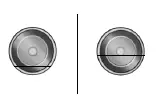Ford Mustang (2005-2014) Owners Manual: Driving through water
WARNING: Drive through water in an emergency only, and not as part of normal driving.
WARNING: Engine damage can occur if water enters the air filter.
Note: Driving through deep water may allow water into the transmission or air intake and can cause internal vehicle damage or cause it to stall.
Note: Once through the water, always dry the brakes by moving your vehicle slowly while applying light pressure on the brake pedal.
If driving through deep or standing water is unavoidable, proceed very slowly. Never drive through water that is higher than the bottom of the wheel rims (for cars) or the bottom of the hubs (for trucks).

When driving through water, traction or brake capability may be limited. Also, water may enter your engine’s air intake and severely damage your engine or your vehicle may stall.
Wet brakes do not stop the vehicle as quickly as dry brakes.
 Economical driving
Economical driving
Fuel economy is affected by several things, such as how you drive, the
conditions you drive under and how you maintain your vehicle.
There are some things to keep in mind that may improve your fuel
e ...
 Floor mats
Floor mats
WARNING: Always use floor mats that are designed to fit the
footwell of your vehicle. Only use floor mats that leave the pedal
area unobstructed. Only use floor mats that are firmly secured to
retent ...
Other materials:
Lumbar Assembly
Removal and Installation
All vehicles
1. Remove the front seat. For additional information, refer to Seat-Front
Power in this section.
2. Release the J-clip.
3. Remove the seat backrest latch handle knob (62762).
4. Pull the seat backrest trim cover ...
Cable and Bracket
Removal
1. Raise the vehicle on a hoist. For additional information, refer to
Section.
2. Remove the cable shift from the shifter lever and bracket and discard
the clip.
3. Remove the bolt from the cable.
4. Remove the bolt from the cable.
5. ...
Checking MyKey system status
You can find information about your programmed MyKeys by using the
information display.
MYKEY DISTANCE
Tracks the distance when drivers use a MyKey. The only way to delete
the accumulated distance is by using an admin key to clear your MyKey.
If the distance ...
